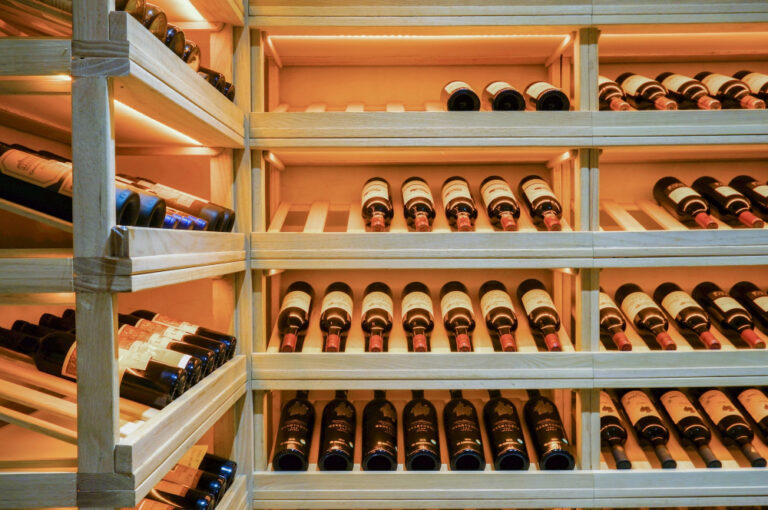Proper wine storage is key to maintaining its quality and flavor in any collection. Yet many wine enthusiasts overlook its importance when selecting their storage solutions – like wine boxes – which can enhance how effectively they preserve bottles. From casual drinkers to serious collectors alike, understanding proper storage procedures for wines will elevate your experience and help guarantee all bottles reach their fullest potential.
Understanding Basic Wine Storage Solutions
Temperature Control
One of the key elements in wine storage is temperature. Ideally, wine should be kept between 45-65degF (7-18degC). Any deviations beyond this ideal can wreak havoc with your bottle’s contents; sudden shifts could age it prematurely or introduce off flavors – for instance, exposure to heat can damage its cork seal allowing air into your bottle and eventually oxidizing your beverage!
Humidity Levels
Establishing and maintaining ideal humidity levels when it comes to wine storage are of equal importance. Aiming for around 70% is recommended; low humidity may dry out corks, leading to premature oxidation or spoilage of wines stored there; on the other hand, too much humidity could result in mold growing on labels and corks, unexpectedly impacting wine quality. If unsure, investing in a hygrometer could provide accurate readings.
Light Exposure
Light, particularly UV rays, can significantly degrade wine over time. Prolonged exposure may lead to chemical reactions which lead to unpleasant flavors; for this reason, it’s wise to store wine away from direct sunlight in a dark area with UV-filtered glass doors and windows in its dedicated storage area for optimal storage conditions.
Types Of Wine Storage Solutions
Wine Refrigerators
A wine refrigerator can be an invaluable investment. These specialized units ensure optimal temperatures and humidity conditions for storing bottles, as well as having adjustable shelves to fit different bottle shapes and sizes.
Traditional Wine Cellars
If space and budget allow, traditional wine cellars offer the optimal storage solution. Wine cellars can be designed to maintain optimal conditions in terms of temperature and humidity regulation for your collection’s preservation, providing consistent storage environments that protect investments while hastening their aging process.
Wine Boxes
For those without room for a wine cellar or fridge, wine boxes offer an effective yet attractive solution for protecting and organizing wine collections. Wine boxes provide your bottles with excellent protection from light exposure and temperature variations while helping organize and make finding specific bottles easier.
Racking Systems
Looking to maximize space? Investing in a wire rack might just be the solution you’ve been seeking! Racking systems by Bijou Wine Cellars come in various designs that allow bottles to be stored horizontally without the risk of cork moisture loss and subsequent cork oxidization.
Best Practices for Storing Different Types of Wine
Red Wine
Red wine requires 55-65degF (13-18degC) as an optimal temperature range when stored for optimal aging and flavor development. Air exposure benefits red wines; thus it should be stored upright if consumed within several months; horizontal storage works better when aged for long-term aging purposes.
White Wine
When storing white wines at cooler temperatures – between 45-50degF (7-10degC), white wines benefit from being chilled before being enjoyed – for optimal refreshment and overall enjoyment. Placing it in the fridge several hours beforehand may help further ensure its freshness!
Sparkling Wine
Sparkling wines should be stored upright to reduce contact between their cork and wine which could disrupt bubble formation and optimal storage temperatures of 45-50degF (7-10degC).
Tips for Maintaining Your Wine Collection.
Regular Checks
A good practice when collecting wine is to conduct routine inspections for any signs of spoilage – leaky bottles or cork failure could indicate spoilage – to make sure that you can enjoy its maximum potential. Keeping an eye on your collection ensures maximum enjoyment from each bottle in your selection!
Inventory Management
Maintaining an inventory of your wines can help you stay organized with what’s on hand and when it’s best to drink them. Being aware of which wines have aged well versus which need to be enjoyed immediately will enhance your wine-tasting experience.
Seasonal Considerations
Keep the changing of seasons in mind when planning storage solutions and environments, especially during hotter periods when temperatures may soar and humidity fluctuates significantly. You may require adjustments in storage solutions as needed to maintain ideal environments throughout all four seasons.
Conclusion
Proper wine storage is key to protecting and enjoying the quality and flavor of your collection. From wine fridges and traditional cellars to practical solutions like wine boxes or storage bins – maintaining optimal temperature, humidity levels, and light exposure is paramount in creating the optimal experience and enjoyment from each wine experience.


